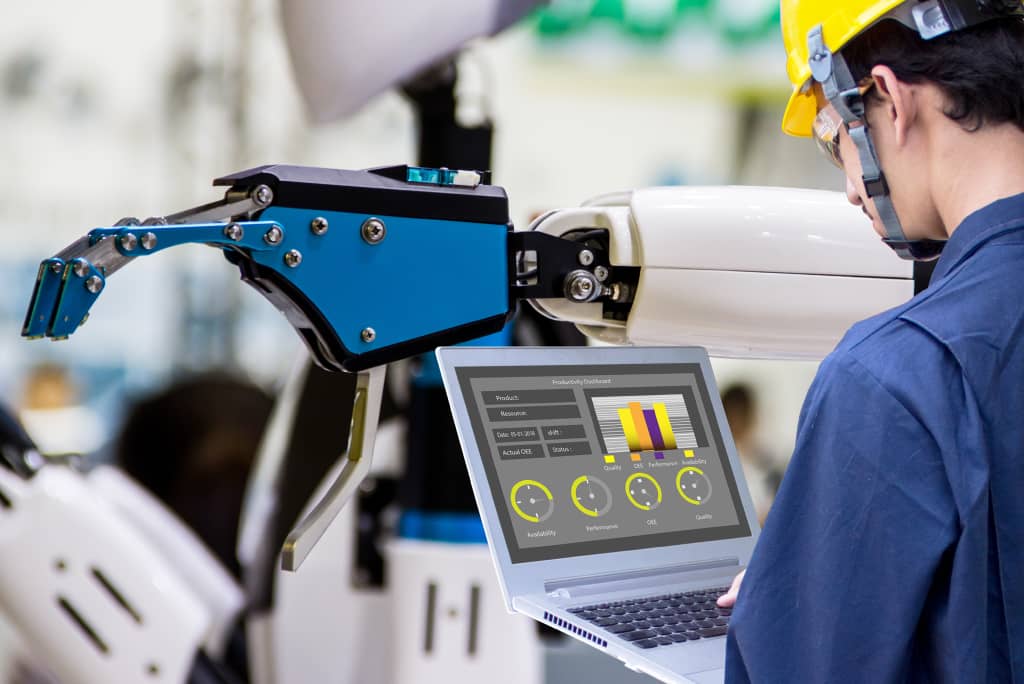RECENT POSTS

Essential Truths About PLC Programming and Hiring the Right PLC Programmer
Programmable Logic Controllers (PLCs) are the brains behind industrial automation, executing complex logic to operate processes safely and efficiently. However, the quality of the PLC system depends on the underlying code and logic.
Just as flaws in critical software can wreak havoc in applications, problematic PLC programming ushers in risks ranging from minor hiccups to catastrophic safety failures.
Conversely, expert PLC code can produce substantial gains in productivity, quality, and profitability.
This article explores insights into evaluating your legacy PLC systems to determine modernization needs, as well as the vital skills to expect from PLC programmers to maximize your long-term process performance.
Red Flags Your PLCs Need Attention
Manufacturing and industrial facilities need to keep pace with technology by refreshing and modernizing their PLCs and associated automation systems. Outdated equipment can hold back capabilities, efficiency, productivity, and future agility.
There are a number of red flags your PLCs need attention and an automation upgrade should be explored. Assessing current automation systems for the following issues can help you determine if your operation could benefit from modernization:
Obsolescence
If PLC hardware components are discontinued or no longer supported by the manufacturer, this causes concerns related to repair, replacement parts, and lack of updates. Difficulty finding compatible I/O modules also signals obsolescence problems.
Performance and Reliability Shortcomings
The frequent failures of aging PLC equipment lead to costly downtime for repairs and troubleshooting. Insufficient processing power, memory constraints, and limited capabilities may hinder adding new features or complexity.
Connectivity and Integration Hurdles
Legacy PLCs often lack advanced communication protocols and direct connections to HMIs, software platforms, and databases needed for data access. This hampers collecting valuable analytics for optimization.
Cybersecurity Vulnerabilities
Outdated PLC systems likely need to be retooled to incorporate modern cybersecurity standards and protocols to mitigate risks associated with connected automation systems.
Lack of Futureproofing
To flexibly support innovations on the horizon, like IIoT, machine learning, and digital twins, next-generation automation systems allow easier integration with new technologies.
Transitioning to Contemporary PLC Hardware
By examining PLC systems for the above limitations, manufacturers can determine whether they need to upgrade to current automation technology to fully leverage new capabilities while enhancing reliability, security, and cost-efficiency. The ideal time to upgrade is before legacy systems start severely impacting operations.
The Risks of PLC Coding Mistakes
Even with the right technology and integration, your controls automation is only as good as the underlying code. Poorly written code or lack of documentation can create a list of potential problems in current operations and in the future.
Overlooking the risks of PLC coding mistakes can cause problems, including unplanned downtime from malfunctions, which disrupts production and creates significant revenue losses. Full outages have the highest cost impact, but intermittent faults impair performance too. Poor code can result in:
- Safety incidents around heavy machinery, chemicals, and other industrial assets leading to injuries, regulatory fines, and legal costs due to inadequate safeguards.
- Higher operating, maintenance, and troubleshooting costs over the long term. Difficult-to-maintain code demands excessive technician work whenever issues emerge.
- Inflexibility in adding new sensors, analytics, and capabilities from hard-coded logic that’s expensive to replace.
- Difficulty tracing the root causes of production quality deviations or unexpected consumption patterns. Poor documentation makes analysis extremely tedious.
While major failures cause the most acute issues, chronic inefficiency, lack of agility, and troubleshooting challenges from bad programming practices still create substantial cumulative costs over time.
Downtime and Lost Revenue
One of the biggest risks is unplanned downtime. A study from Aberdeen Research estimates the cost of downtime in manufacturing at up to $260,000 an hour. If you have to shut down for a day to fix bad code, it can cost you more than $2 million in lost revenue and productivity.
Safety Issues
Safety is paramount in industrial settings. Yet, PLCs that lack the proper safeguards put workers at risk. Every year, about 2.3 million workplace injuries occur. Accidents in the industrial and manufacturing sectors are among the top industries for mishaps.
Not only does poor PLC programming put your workers at risk, but there may also be substantial penalties from regulatory agencies like OSHA. Accidents may also trigger inspections and additional fines, especially in regulated agencies like energy or pharmaceuticals.
Suboptimal Performance
Inefficient code can also be costly in less obvious ways. For example, it can be more difficult to troubleshoot or update. It may prevent you from integrating new capabilities or making changes. It can also make it extremely challenging to diagnose the root cause of a specific problem and result in time-consuming and expensive reprogramming and maintenance.
Boosting Business Performance: the PLC Programmer’s Role
PLC programmers play a crucial role in boosting business performance in several key ways. Solid PLC coding produces significant benefits, including:
- Maximizing uptime: By writing robust, bug-free code and implementing adequate fault handling, the PLC programmer minimizes downtime from malfunctions. This helps ensure as close to 100% uptime as possible.
- Enabling flexibility: Modular, well-documented code allows production engineers to readily make changes to implement new sensors, analytics, line configurations, and control schemes. This agility boosts capabilities.
- Optimizing processes: Beyond just enabling operation, the PLC code defines process control logic that can directly optimize throughput, quality, consistency, and cost-efficiency through strategies like automation, dynamic set points, and predictive analytics.
- Creating visibility: Code should help generate production data and KPI dashboards. By extracting key metrics through human–machine interfaces (HMIs), visualization, and software integration, the PLC provides transparency for continuous improvement.
- Prioritizing safety: Strict programming of interlocks, operator permissions, alarms, and fail-safe defaults prevents injuries and accidents. This avoids regulatory fines while protecting the workforce and profitability.
- Easing maintenance: Well-structured code with ample commenting enables easy troubleshooting by technicians to reduce maintenance overhead.
- Future-proofing: Careful planning of spare I/O, bandwidth, and scope accommodates easy expansion. Code flexibility eases integrating new modules to make future changes or additions possible.
By working with expert PLC programmers like the team at Pacific Blue Engineering, you can significantly boost your capabilities and performance.
Optimizing PLC Code for Speed and Efficiency
Efficient PLC code allows machines and processes to operate at optimal speeds.
Techniques like leveraging subroutines to break programs into reusable code blocks improve organization. Parallel processing enables independent sequences to run simultaneously rather than waiting, maximizing scan efficiency. These faster and leaner programs minimize start/stop times and delays.
Implementing Predictive Maintenance Capabilities
Unplanned downtime is expensive. PLCs can enable self-diagnostics to catch problems early.
For example, performance tracking monitors cycle times or motor currents to identify declining performance, thus requiring preventative maintenance. Analytic algorithms can also predict failures based on PLC sensor data.
Improve Operator Interface Design
Well-designed HMIs empower personnel to smoothly run production. Intuitive navigation and dashboards prominently display key overall equipment effectiveness (OEE) metrics.
Tighten System Integration
While PLCs control localized sequences, integration with ERP systems and MES optimizes broader workflows through data sharing. This can involve exposing PLC data to align with business KPIs or sending real-time alerts about potential deadline misses.
Add Remote Monitoring and Control
Connecting PLCs remotely boosts responsiveness. Secure remote monitoring allows reading registers without on-site visits to catch issues early. Remote control routines allow starting, stopping, or cycling essential operations after identity verification for quick incident response.
Signs of an Excellent PLC Programmer
Making sure you engage top-quality PLC programmers for your controls engineering project is crucial to long-term success. So, what should you look for in a PLC programmer? Here are some of the areas where you should ask about their skills.
Technical PLC Expertise
Mastering popular PLC programming languages used in the industry is crucial. For instance, ladder logic represents programs through diagrams resembling relay circuits. Structured text uses programming statements like IF-THEN-ELSE. Gauging competence in major paradigms reveals capability.
Equally important is proficiency in programming the leading PLC brands you utilize. Familiarity with your equipment streamlines integration.
Domain Experience
Programmers possessing a background in your industry understand standardized workflows, machinery, and automation.
Problem-Solving Ability
PLC issues require methodical troubleshooting like optimizing conveyor logic or tracking down network faults. Analyze the candidate’s critical thinking by presenting real-world programming scenarios and assessing investigative questioning.
Calm under pressure during outages also demonstrates aptitude. Ask about their experience with difficult situations.
Communication Skills
Collaborating with technicians, managers, and stakeholders is crucial to success. Programmers who effectively explain technical details and proactively provide progress updates to non-programmers prove invaluable.
Understanding the Change Process
It’s also important to assess how nimble and adaptable programmers are to change requests. Updating code logic, HMI screens, analytics, or interfaces often requires revision based on shifting needs. A programmer who is agile and understands the Programmable Logic Controller (PLC) change process will be more adept at dealing with modifications and eliminating unintended side effects.
Look for Warning Signs in PLC Programmers
Just as you want to look for warning signs that your PLC programming needs upgrading or modernizing, you also want to look for the red flags that indicate potential staff problems, such as a lack of professionalism. Controls systems are critical in your operation, and you need to be able to trust that anyone who works on them is competent and reliable.
If you encounter any of these situations, it should give you pause.
- Vague experience: Programmers speaking in generalities, without concrete examples or verifiable references, should raise suspicion. Insist on detailed accounts of specific projects and results.
- Lack of technical specificity: Seasoned experts discuss code optimization techniques with precision. The inability to articulate such specifics likely signals deficient subject matter mastery.
- Blaming others: Disparaging former colleagues or companies demonstrates problematic behaviors. Mature professionals accept personal accountability for work relationships and results.
- Overpromising capabilities: Exaggerated claims about skills or guaranteed outcomes, without understanding project details, warrant skepticism. Experts set realistic expectations.
- Limited hardware knowledge: With complex PLC hardware, candidates should have mastery of associated modules, I/O, networks, and device integration beyond just software logic.
Mistakes to Avoid When Choosing a PLC Programmer
There are also a few common mistakes that organizations make when investigating where they can find expert PLC programmers near them, including:
Neglecting Project Scope
Failure to accurately outline programming requirements upfront causes downstream issues. Be specific on the nature of logic, equipment, interfaces, and special considerations. Evaluate programmers through the lens of defined specifications.
Focusing Too Heavily on Cost
While budget matters, the cheapest programmer often ends up costing more in errors and delays than a qualified one. Prioritize capability over cost.
Not Confirming Domain Experience
Just listing an industry does not guarantee relevant knowledge. Push for details on companies supported and projects accomplished. Probe their equipment insights within your niche.
Neglecting Previous Employer Input
Speaking only to provided references gives limited insight. Conduct backchannel outreach to past managers or customers for unfiltered feedback on competencies, communication, and handling pressure.
Disregarding Potential Culture-Fit Issues
Technical prowess matters but so does cooperation and alignment with organizational values. During discussions, notice interpersonal nuances around communication, collaboration, and conveying complex concepts.
Rushing Decisions Based on Urgency
Project delays often rush subpar hiring. Diligently vet candidates regardless of production demands. Quickly onboarding unvetted programmers often requires costly cleanup work later and can sideline your organization for months and years to come.
Where Can I Find Expert PLC Programmers Near Me?
When selecting a PLC programming partner, an experienced provider like Pacific Blue Engineering helps you avoid costly mistakes, including:
- Projects failing to deliver a full scope of work
- Schedule disruptions from changes or delays
- Improper programming disrupting safety
- Inadequate reliability or efficiency
- Insufficient resources stretching projects
The Pacific Blue Engineering team has substantial expertise across core competencies like PLC code, HMI design, system integration, and custom automation. Just as importantly, our PLC programmers demonstrate integrity in all aspects of work from transparent communication to diligent testing and documentation.
With Pacific Blue Engineering, clients gain the benefit of our team’s seasoned technical strengths combined with an underlying work ethic that takes ownership of delivering successful outcomes according to project commitments.
Frequently Asked Questions—FAQs
When is it time to find a PLC programmer for hire for my facility?
It’s time when your current internal team lacks sufficient expertise or bandwidth for upcoming initiatives involving new equipment, process changes, upgrades, additional analytics, or IIoT integration.
How can proper PLC programming support sustainability goals?
Optimized logic minimizes energy waste through tighter shutoff controls, dynamic motor scaling, and smart scheduling routines to match supply and demand. PLC analytics also provide data visibility to evaluate and make decisions about sustainability in production.
What should I expect when upgrading PLC hardware/Software?
When upgrading PLC hardware and software, several key activities should be expected. Validation testing will confirm the new I/O mapping aligns properly, drivers integrate essential peripherals, and fault handling responds appropriately to anomalies. Existing code logic will be retrofitted to take advantage of new PLC capabilities or instructions that were not previously available.
Operator retraining will ensure personnel are familiarized with any HMI design adjustments or workflow changes implemented with the upgraded platform. Finally, onsite commissioning support will methodically step through transitional sequences and cutovers to minimize debugging and risks during go-live events.
Need help with PLC programming and controls system engineering? Contact Pacific Blue Engineering today at (657) 201-8603 or request a consultation online.
similar posts
Certifications
Contact Us
Telephone:
Corporate Office “The Shop”
Pacific Blue Engineering, LLC
2880 Orange Ave
Long Beach, CA 90755
© All contents copyright © 2023 by Pacific Blue Engineering













